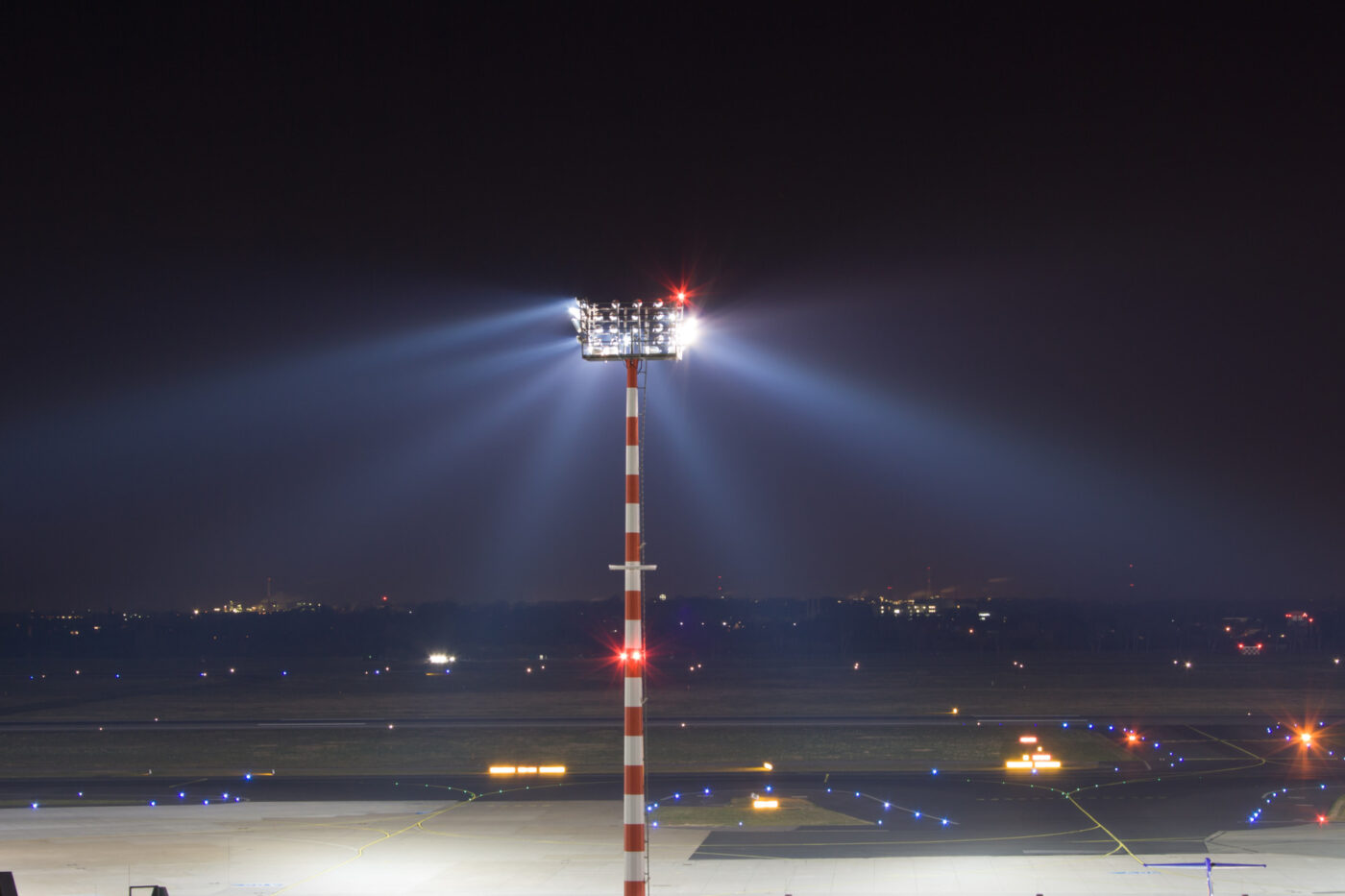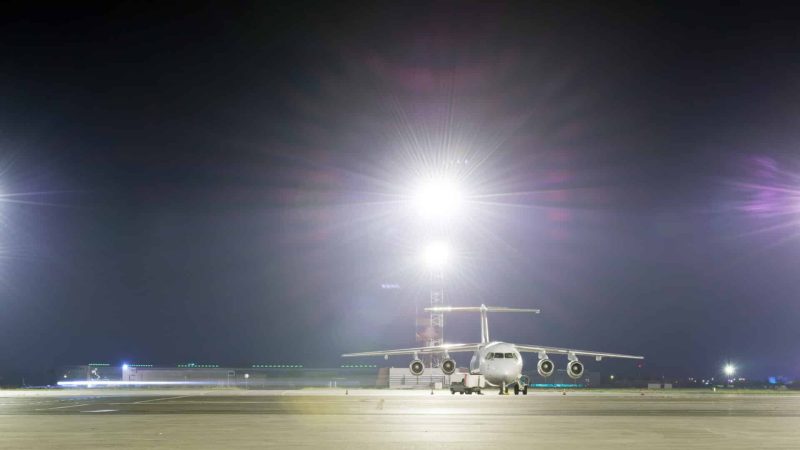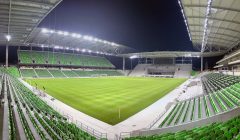Under the cover of night, a pilot skillfully navigates a Boeing 737 through the clouds, preparing for landing. The runway ahead shines brightly, providing guidance through the potentially hazardous darkness. This tranquil scene is made possible by the airport lighting system.
This article will explore how modern lighting technologies, specifically LED lights, have significantly improved safety and operational efficiency at airports.
Table of Contents
ToggleUnderstanding the Basics of Airport Lighting
Airport lighting plays a role in aiding pilots’ visibility during low-light conditions or adverse weather situations. Different types of lighting, such as runway lighting, taxiway lighting, obstruction lighting and apron lighting, serve purposes in navigating the airport environment.

The adoption of LED technology has greatly improved the quality and efficiency of these lighting systems, offering illumination that lasts longer while being more energy efficient.
Types of Airport Lighting
- Runway Lighting: Helps in delineating the runway edges and ends, which is crucial for takeoff and landing operations.
- Taxiway Lighting: Guides aircraft from the runway to the apron area and vice versa.
- Obstruction Lighting: Warns pilots about obstacles in and around the airport.
- Apron Lighting: Ensures the safe movement of aircraft and personnel in the apron area.
- Approach Lighting: Aids pilots during the approach phase, especially in poor visibility conditions.
Lighting Colors and Patterns
In order to maintain consistency across airports, standardized colors and patterns are employed in airport lighting systems. Each color is designated for purposes such as runway, taxiway and approach lighting systems. These lighting systems follow a layout of lights and colors to assist pilots during both ground operations. At airports, the behavior and colors of the lights can be a response to real-time traffic conditions, ultimately enhancing safety and efficiency.
Transition to LED Technology
The implementation of LED technology has revolutionized airport lighting systems by offering quality and efficiency. LEDs provide illumination that’s crucial for airport operations. Additionally, they are more energy efficient compared to other lighting solutions while also boasting a longer lifespan.

This shift towards LED technology supports the concept of illuminating airports in order to mitigate risks associated with flying. The adoption of LEDs has significantly enhanced visibility and durability within these lighting systems, making contributions to efficiency and overall safety at airports.
Safety Enhancements Through Airport Lighting
As stated earlier, visibility plays a role in ensuring safety at airports. Having lighting is extremely important to prevent accidents on runways and guide pilots during moments like takeoff, landing and taxiing.
In times of emergencies, designed lighting systems can greatly assist in evacuation and rescue operations, reducing the risk of casualties.
- Improved Navigation: Improved lighting systems help pilots identify the runway, taxiway, and other crucial areas within the airport premises more effectively, especially during adverse weather conditions.
- Obstacle Identification: Lighting systems also aid in obstacle identification and avoidance, which is crucial for preventing accidents.
- Smart Lighting Management: Intelligent Lighting Control and Monitoring Systems (ILCMS) have the capability to manage lighting in a way that aids aircraft movements, such as the ‘Follow the Greens’ scheme, which sequentially lights up the taxiway to guide aircraft to and from the gates.
Efficiency and Operational Improvements
The use of LED lighting has opened up possibilities for airports to operate in an energy-effective manner. LED lights have a long lifespan. Also, they require less maintenance, which helps minimize disruptions in airport operations and ensures a seamless workflow.
- Energy Efficiency: LED lights consume less energy compared to traditional incandescent bulbs, which translates to lower energy bills, reducing the operational costs for airports.
- Durability: LED lights are known for their durability and longer lifespan, which means less frequent replacements are needed. They are also less susceptible to damage from harsh weather conditions, further lowering maintenance costs.
- Improved Visibility: LED lighting enhances visibility on airfields and taxiways, which is crucial for pilot navigation, especially during adverse weather conditions.
Incorporating LED technology in airport lighting systems not only significantly contributes to safety but also to the efficiency and sustainability of airport operations.
Future Trends in Airport Lighting:
Airport lighting has embraced the integration of technologies such as IoT, allowing for real-time monitoring and management of lighting systems. Furthermore, the emergence of solar-powered lighting paves the way for a future in airport operations.
- Continued Adoption of LED Technology: The adoption of LED technology in airport lighting is projected to continue growing, reshaping the future of airports worldwide.
- Intelligent Lighting Control and Monitoring Systems (ILCMS): As the demand for air travel continues to climb, upgrading existing airport infrastructure, including intelligent ground lighting systems, is becoming imperative. ILCMS can manage lighting in a way that aids aircraft movements and enhances the passenger experience.
- Sustainable LED Lighting Strategies: With technology advancing and costs decreasing, LED lighting systems are predicted to become the norm across all airports worldwide. These systems provide enhanced visibility, energy efficiency, and durability, contributing to safer and more efficient runway operations.
Learn more about How Commercial LED Lighting Transforms Retail Spaces
Economic Impact of Efficient Airport Lighting
Efficient airport lighting and LED lighting have an impact on the financial aspects of airport operations. LED lights are known for their energy efficiency consuming power compared to other types of lighting systems. This not only helps in reducing energy costs for airports but also contributes to a sustainable environment. Studies have shown that LED lighting can save up to 75% of energy when compared to lighting systems.
Durability and Cost-Effectiveness
The durability of LED bulbs is another advantage, as they last up to 25 times longer than incandescent bulbs. This longevity reduces the frequency of replacements. Subsequently lowers maintenance costs for airport operators.
Safety and Visibility Enhancements
The bright and consistent illumination provided by LED lights improves visibility in areas such as runways, terminals and parking lots. This enhanced visibility promotes safety and potentially decreases liability expenses.
Environmental Advantages of LED Lighting
LED lighting is environmentally friendly due to its low heat generation and absence of materials like mercury. This makes them easier to dispose of while also reducing the carbon footprint associated with airports.
Long-Term Financial Viability
Although there might be a cost involved in installing LED lighting systems, the long-term advantages outweigh this investment. The energy efficiency and extended lifespan of LED lights result in cost savings over time, making them a viable solution in the long run.
Smart Lighting Systems for Airports
Furthermore, incorporating lighting systems enables airport operators to remotely control and monitor the intensity of LED lights based on light availability. This intelligent adjustment saves energy during daylight hours. Also, it allows for efficient utilization of resources. This, along with the fact that LED lights produce less heat and therefore require minimal cooling systems, leads to reduced operational expenses and a more environmentally friendly airport operation.
Key takeaway: LED lighting in airports offers several advantages. It helps save on energy and maintenance expenses, improves visibility for safety and contributes to sustainability by reducing carbon emissions.
Conclusion
The importance of airport lighting in ensuring safety and efficiency in airport operations cannot be overstated. As airports progress, collaborating with forward-thinking companies such as NationalLED for customized lighting solutions could be the catalyst for achieving levels of safety and operational excellence. The trends mentioned earlier emphasize the role that innovative lighting solutions play in shaping the future of airport operations. By embracing these advancements, airports can greatly improve their efficiency, safety and sustainability, positioning themselves favourably within the aviation industry.








